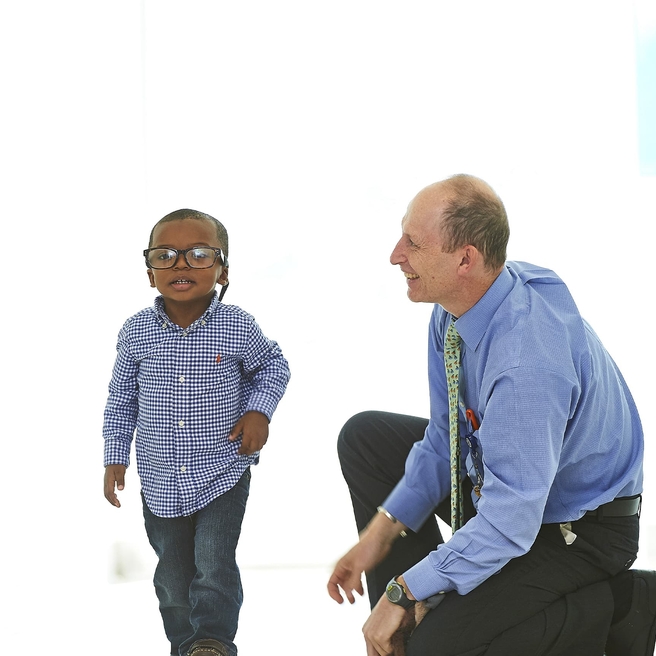What is a cataract?
A cataract is any cloudiness or opacity of the lens of the eye, which is normally clear. The lens sits inside the eye, just behind the iris. It is about the shape and size of an M&M’s® chocolate candy. Pediatric cataracts may occur in one or both eyes.
There are many types of cataracts, and they can range from mild to severe. Some types of cataracts do not interfere with vision and therefore require no treatment, while others may cause severe vision loss and require surgery.
Causes
There are many different causes of pediatric cataracts. Cataracts may be present at birth or develop during childhood. Some cataracts are caused by abnormal lens development during pregnancy. Others result from genetic or metabolic problems, or infections. Cataracts can also happen spontaneously without a known cause.
Most pediatric cataracts are an isolated finding and are not associated with other medical problems.
Cataracts symptoms
Symptoms of cataracts can vary from child to child, but may include:
- Decreased vision in the affected eye
- Whitening or clouding of the lens
- A white or dark pupil reflex on photographs
- A wandering or crossed eye (strabismus)
- Light sensitivity
- Holding items close to the eyes to see them
It is important to note that some children with cataracts display no symptoms. Young children can often appear to function well with lower vision. Or, if only one eye has a cataract, the child uses the unaffected eye for all their visual tasks.
Diagnosis
A pediatric ophthalmologist should be seen immediately if there is concern for a vision issue or cataract in a child.
Vision screenings should be performed annually at the pediatrician’s office and at school. Photo-screening, a type of vision screening that uses a special camera to determine if a child has an eye issue, is often performed at the pediatrician's office in conjunction with vision testing.
Treatment
The goal of cataract treatment in children is to:
- Maximize and optimize you child’s vision and visual development
- Identify and treat the underlying cause if one exists
Treatment for cataracts depends on the size, severity and location of the lens clouding caused by the cataract. Small cataracts that are not significantly interfering with vision can be monitored by a pediatric ophthalmologist, often without any need for treatment.
Larger cataracts that are impacting image quality and degrading your child's vision need to be removed surgically. Cataract surgery is performed at Children’s Hospital of Philadelphia's Main Campus location.
Depending on the age of your child, an artificial plastic lens may be placed in the eye during the initial cataract surgery. This is how adult cataract surgery is done.
Typically, in patients less than 1 year of age, no intraocular lens is placed. Several years later, when the child has grown, a lens can be implanted.
After cataract surgery, short-term treatment with antibiotic and anti-inflammatory eye drops is required.
Follow-up care
Long-term follow-up is important after cataract surgery in children.
- Frequent visits are required to monitor and maximize visual development and check for common complications, such as amblyopia, or elevated pressure in the eye (glaucoma).
- After cataract surgery, most children require contact lenses or glasses to allow for a clear and focused image and to maximize their visual development.
While cataract surgery is performed at the Main Campus, follow-up can take place at other CHOP Care Network locations that are most convenient to your family.
Long-term outlook
Cataracts can cause severe vision loss in children, but fortunately if treated promptly this can be fully averted. Treatment is often highly successful as long as children and families stick to the treatment plan.
Why choose CHOP for treatment of cataracts in children
At Children’s Hospital of Philadelphia (CHOP), your child will be cared for by leaders in the field of pediatric ophthalmology clinical care, surgery and research. We complete a high volume of pediatric cataract surgeries every year, and have extensive experience in all types of pediatric cataracts. Your child will have access to all aspects of expert care required for cataract surgery and subsequent follow-up management.
Resources to help
Division of Ophthalmology Resources
We have collected helpful resources on pediatric eye care so you can feel confident in the care you're providing your child.
Reviewed by William Anninger, MD
